Text
『ディヴァイン・ダンス三番叟』「月見座頭について」
日程:2018年9月19日(水)~9月25日(火)※9月23日休演
会場:パリ市立劇場 エスパス・カルダン
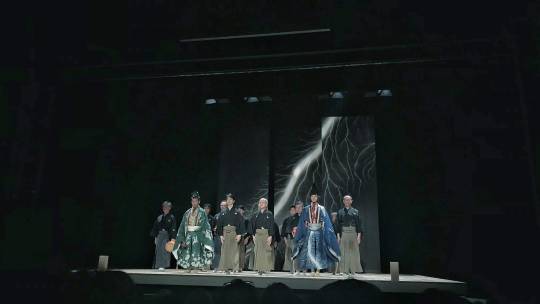
『月見座頭』
奇妙な狂言だが、狂言に固有のある種のおかしみを映す、非常に興味深い一曲だ。
ある座頭が、盲目ながらも名月の晩に、せめて虫の音を愛でようとやってくる。そこで月見に来た一人の男と行き会い、一献を交わす。ほろ酔いの良い気分で両者は歌や踊りに興じる。酒も尽き、宴を切り上げることに。別れの挨拶をしそれぞれ家路につく。
ところがふと男は踵を返し、杖をつきつき歩を進める座頭に突き当たって打ち倒す。さらに杖を放り投げ、高笑いして去っていく。手探りに杖を探し求める座頭の漏らす哀れなつぶやきに、次いでくさめが二度、響きわたる。
「最善の人には引き替え、情けもない奴でござる……」
野村万作演じる座頭が愛おしげに虫の音に耳を傾ける姿は胸に迫るものがある。野村萬斎演じる上京の男の、無造作な翻意もまた、背にひやりとしたものを走らせる。
本作は日本での現代上演では、もっともらしく「人間の二重性を描く」などと但し書きされることが多いようだ。
さて本作は、確かに狂言のもつある種の「おかしみ」の見事な例だ。
しかし、それは観客に届いただろうか?
幕間に、同行した日本人男性と所感を語り合っていると、隣席の紳士から声をかけられた。五十代と思しきその男性は、私の文化に冒涜とならないようにか、とても丁寧な口調で、作品の解説を求めた。
簡単に、男の翻意に理由がないこと、日本でも現代ではこれがユーモアとして解されることは少ないことや、本公演が杉本博司演出版であり、照明の操作などが、それをわずかに感じられることなどを伝えると、とても満足そうに、隣の夫人と驚きを口にしていた。
そのなかで、誤解をおそれずこんな解釈を口にしてみた。座頭は、今回単純に「Aveugle(盲人)」と訳された。訳はこれで問題ないだろう。ただ、その存在については一言補足してもいいかもしれない。座頭は、近代文学・演劇における「ユダヤ人」に近い。彼らは非力で、あわれで、取るに足らない(marginalisé)。しかし同時にしたたかで、強欲な(金貸しを許されていたというのも、類似点だろう)、唾棄すべき存在でもある。そうした両義的な感情が前提としてあって初めて、座頭を打擲する男の高笑いに、われわれは暗い爽快感を覚える。
本公演の配布物は、A4用紙を二つ折りにした形の簡便なものだった。表紙と裏表紙の協賛関係の情報、出演者情報を除くと、内容はその殆どが三番叟を扱うものであった。
フランスの観客は、作品の背景情報、周辺情報に非常に貪欲であり、ブックレットを読み込んだり、解説ラジオを事前に聴くという人も珍しくない。また、劇場側でもそれに応えようと、オデオン劇場やシャンゼリゼ劇場などの配布物は充実した印象だ。
戸惑いをみせた観客は他にもみられ、前列では4・5人の観客が幕間で席を立った。彼・彼女たちは、開演前はしきりに狂言についての知識を披露しあっており、笑劇を楽しみにしていたようすであった。
私個人としては、月見座頭は大変素晴らしい一曲だった。しかし、それをフランスの観客に「届ける」という意味で、大変惜しいことをしたと思う。
どうすれば、このような上演作品を「翻訳」し「届ける」ことができるか、いま一度考えたい。
公演タイトル:野村万作・萬斎・裕基 × 杉本博司『ディヴァイン・ダンス 三番叟』
上演作品:『三番叟』、『月見座頭』
会場:パリ市立劇場 エスパス・カルダン
公演期間: 2018年9月19日(水)~9月25日(火)※9月23日休演
構成・美術:杉本博司
主催:国際交流基金、パリ市立劇場
共催:公益財団法人小田原文化財団、フェスティバル・ドートンヌ・パリ
制作協力:公益財団法人せたがや文化財団 世田谷パブリックシアター
主な出演者:
野村万作
野村萬斎
野村裕基
0 notes
Text
『贋作 桜の森の満開の下』パリ公演
パリ・シャイヨー劇場 サル・ジャン・ヴィラール
作・演出 野田秀樹
ジャポニスム2018作品群の一つとして来仏し、シャイヨー劇場で上演された贋作・桜の森の満開の下を観た。本作は1989年に初演され、それからキャストを替えて幾度も再演されている。昨年夏には歌舞伎上演が行われたのも記憶に新しい。今回の再演の過去版との比較については、日本(東京・大阪・北九州)公演についても多くの評がでるであろう。そこで特に海外公演、パリ公演について思ったこといくつか。
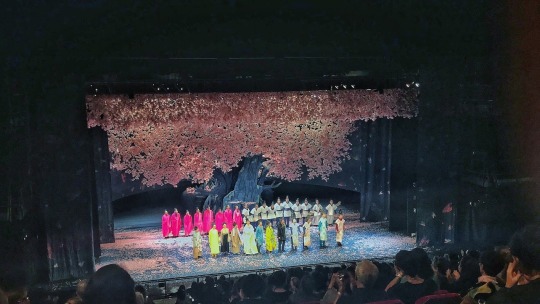
野田秀樹の言葉と字幕訳
野田秀樹の戯曲が、演劇が、言葉を建材のように文字通り組み上げたものであるということは、我々日本人の観客にとっては長く自明のこととなっている。彼は豊富なオノマトペ、駄洒落、掛詞といった要素を、劇作上の遊戯としてのみでなく、作品の根幹として、また軸として用いる。自ずと、翻訳は困難な作業になる。
さて、演劇作品の「翻訳」といった場合、その語は複数の全く異なる作業を指し示す。例えば出版のための翻訳、上演台本としての翻訳、そして字幕のための翻訳。さらにそれぞれを細分化していくこともできるのだかここでは差し控えよう。さて今回の公演では、3つ目の「翻訳字幕」が用いられたわけである。この字幕翻訳は非常に厄介で、俳優の話す台詞に合わせて観客が読むことのできる字幕は、往々にして台詞よりも短縮・単純化されたものであることが要求される。またオペレーションの問題がある。時折知らない人があるが、舞台作品の字幕というのは、映画などと異なり、生の演技を観て、台詞を聴いて、字幕スライドをひとつずつ送っていくオペレーターというのがいるのだ。無論、これは両言語に精通し、かつ台本を隅から隅まで読み込んだ人物でなければならに。
結論からいうと、コリーヌ・アトランによるフランス語字幕は出色の出来だろう。言葉のスピード感やリズム感は、野田作品の特色のひとつである。幕開けの場面では、字幕のあまりの速さに疑念が首をもたげた。非・日本語話者の観客は、この速さに、ついていけるだろうか?しかし、しばらく観ていると、字幕の表現が平易で、かつ構文的短時間での理解を助けるものとなっていることに感心した。原語に囚われすぎずに仏語での冗談や言葉遊びを交えつつ、オノマトペや掛詞を中心に多くの表現を思い切って諦めている。それによって、作品のスピード感に付いていく字幕が制作されている。改善点があるとすれば、訳文の配置とオペレーションである。猛スピードの字幕文と台詞との間に、しばしばズレが生じる。字幕鑑賞者にとって、このズレは作品のリズムを損ねる、致命的なものとなる。
視覚美と肉体言語の雄弁さ
堀尾幸男の美術の力強さ。指の間からこぼれ落ちる花弁のように移ろいやすい野田秀樹の世界に姿を与える。特に各種の素材の特性を活かし、瞬間的に舞台上の景色を変貌させるいくつかの仕掛けに、観客はため息を漏らした。
東京公演の行われた東京芸術劇場プレイハウスの834席に対して、シャイヨー劇場サル・ジャン・ヴィラールは1250席とおよそ1.5倍の収容人数を誇る。(またプレイハウスに比べて反響の少ない、客席上部の空間の大きい構造になっている)俳優たちは、その肉体を躍動させ広い舞台上を埋めた。その訓練された群体(corps)としての動きを称賛する囁きは、幕間にもきかれた。しかし全体を通すと、心なしか俳優たちの動き、とりわけ出ハケに不必要なストロークが伴うように感じられた。また、しばしば俳優たちの声量は及ばず、滑舌がもつれる部分が認められたが、後者は些末なものだろう。前者の声量については、現地の観客の多くが字幕を追っていたとしても、作品の圧力に関わる問題だ。とはいえ、これらの難点は俳優に責のあることではなく、ストレートプレイには大きすぎる1200席の大劇場という空間に由来するものだろう。
野田演劇の本質は、ひとつにその過剰性にある。言語だけをとってもその物語、単語、響き、形の要素が多重露光に重なっている。さらにそこに美術、衣裳、音楽、照明、俳優の肉体、その動き、そして各要素の相互作用が、歪んだ万華鏡のように並立しながら変貌していく。
その意味で、野田演劇はその全貌を「受け取り」きれないものであり、翻ってみればその全貌を「伝える」必要がないのだ、といえるかもしれない。そうだとすれば、本作品は野田演劇のエッセンスを、パリの観客にもたらした。終演後、耳に入った断片的な感想の多くには、困惑とともに作品への好意が滲んでいたことを書き記しておこう。
出演 : 妻夫木聡/深津絵里/天海祐希/古田新太/秋山菜津子/大倉孝二/藤井隆/村岡希美/門脇麦/池田成志/銀粉蝶/野田秀樹
美術 堀尾幸男/照明 服部基/衣裳 ひびのこづえ/音楽・効果 原摩利彦/音響 zAk/振付 井手茂太
1 note
·
View note
Text
IROMOYŌ CHOTTO KARIMAME (KASANE)/NARUKAMI
September 14, 2018. Théâtre national de Chaillot, Salle Jean Vilar
Nakamura Shidō II, Nakamura Shichinosuké II
Une bonne partie du public sont les japonais expatriés. Des audioguides en échange d’une pièce d’identité, qu’on a amené du Japon. Un tier étant des traductions réduites des répliques, les deux autres se consacrent aux explications de la coutume, de la musique et des gestes kabukis.

L’érotisme fort de Shichinosuké qui interprète Kasané, victime déformée par le karma de son père le fantôme. Shidō joue justement le rôle du scélérat Yoémon. Or, un étrange sérieux remplissait la salle Vilar, dépourvu d’Ōmukō ( littéralement au-delà, sont des amateurs crieurs qui appellent traditionnellement les noms des acteurs principaux au moment précis d’une pièce Kabuki. Même si la tradition est historiquement spontané, leurs cris jouent aujourd’hui une rôle majeure dans une représentation). Le style musique de Kasané, Kiyomoto, est lyrique mais sentimental, une qualité anti-drame qui donne à la tragédie une légèreté et une mélancolie. La beauté de la main pâle et molle qui tire à la fin.

Shidō et Shichinosuke m’a surpris dans Narukami. Shichinosuke joue passionnément Princesse Kumo no Taéma, une fille astucieuse et séduisante. Le comédien, qui est réputé pour les rôles nobles et posés, dirige son corps pour se montrer plus petit que d’habitude, soulignant la coquetterie de Kumo no Taéma. Narukami Shōnin de Shidō n’est pas tout à fait convaincant ni comme un moine innocent, ni comme un puceau libidineux. Toutefois, une fois dans le coiffeur Igaguri et la maquillage Kumadori, il impressionne avec la force de son rage. On aimerait bien avoir vu une transition plus plus lisse entre le moine digne et l’homme conquis.
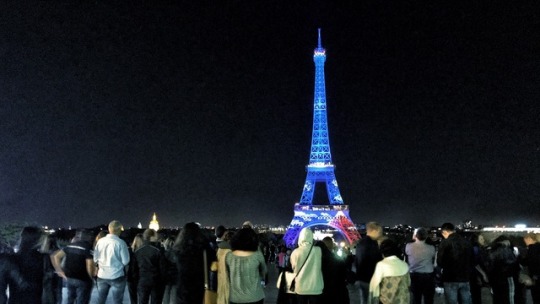
On dirait que Narukami est une histoire molièresque. Le combat lusteux entre Narukami et Kumo no Taéma est pareil à celui entre tartuffe et Elmire. Or, Narukami n’est pas hypocrite. Au début de la pièce, il est un moine et un magicien puissant, digne et prudent. Mais il faut être cohérent même si ce prude tombent facilement victime devant la charme de Kumo no Taéma, perdant sa magique. Une qualité spéciale est requis pour en achever, par exemple c’était pour Ichikawa Ebizō IX, qui a joué le même rôle en 1956, sa beauté impeccable. Quand Kumo no Taéma, une jeune fille qui, son véritable amour en jeu, visite Narukami en mission secret, la chasteté et la beauté radieuse du moine l’encourage jette l’huile sur son feu. Autrement, la déplétion de la bonté de Narukami, dans la première moitié de la pièce, soulignera la force de son indignation face à la trahison. Ainsi, le rôle de Narukami exige aux comédiens à jouer tout le spectre des caractères.
2 notes
·
View notes
Text
色彩間刈豆かさね・鳴神
2018年9月14日
シャイヨ―劇場ジャン・ヴィラール劇場
中村獅童・中村七之助ほか

客層は在仏邦人多め、仏人観客の年齢層はやや高め。オーディオガイドが身分証と交換で貸出、装置は日本からの持ち込み。体感としては台詞の3分の1程度の仏訳と、慣例や音楽、身振りの解説。


亡者の因果を負って醜く歪んだかさねの妖艶さ。獅童の与右衛門も、脛に傷のある悪党は似合い役か。それだけに、大向う不在のシャイヨーの大劇場には妙に重い空気。清元の語りは、叙情的でありつつその湿っぽさがかえって反ドラマ的で、悲劇をあくまで美しく、爽やかにまとめるのだけど、その響きをくぐもらせる感じ。引き戻しの青白い手の美しさ。
鳴神の獅童七之助は両者驚きがあった。七之助はよく口の回る小気味の良い雲の絶間を好演。姿よく、気品や気位を感じさせる役のイメージが強かったが、いつもよりやや小柄に見せる身振りでお見事。一方の獅童は、清廉な坊主としても、好色な奥手男としても今ひとつの説得力。ところが一転、毬栗に隈取の荒事は振り切れた勢いを見せた。それだけに、鷹揚な上人からの流れがもう少し出ればと口惜しい。

鳴神は、モリエレスクな物語である。鳴神上人と雲の絶間姫の攻防は、ほとんどタルチュフとエルミールだ。興味深いのは、鳴神上人は偽善者というわけではなく、あくまでも潔癖な童貞であるということ。それでいて、雲の絶間の誘惑に舞い上がり、あっという間に陥落して法力を失うことに、驚くほどの連続性がある。そう見せるのに、説得力がいる。例えば先々代の海老蔵の有無を言わせぬ美貌。雲の絶間は、想い人と結ばれんと密命を帯びて上人を訪れる。鳴神上人の純情と、涼やかな面差しが、彼女の奮闘に拍車をかける。裏切られた上人の憤怒の相も、前半のおおらかな善人によって引き立つのだろう。
1 note
·
View note
Text
BELGRADE THEATRE TOUR #01
8 July 2018 Sunday
The tour was part of the Congress 2018 of the International Federation of Theatre Research(IFTR), held in Belgrade on the 9th to the 13th of July 2018.
Apart from the conference itself, the conveners provided us with several showcases, side programs and social and cultural events.
« Walk down Belgrade Theatres » tour was one of the cultural events.
Organized on the 8th and the 14th, I participated in the first, on Sunday the 8th, to gain a framework for the coming week of intensive immersion and experience of the Serbian culture, arts and academism.
Participants were from London(Researcher/actor), New York, India(*2), Taiwan, and Japan(*2).
Our guide was Dr. Jelena Kovačevic , in charge of the Library and Artistic Archive at the Yugoslav Drama Theatre, and with Sanja, who arranged and managed the whole social program, our group was all in all 9 people, all of the pronoun she.
The tour started at the Student Square, and within minutes, arrived at our first destination, The National Theatre.

Founded in 1868, this state theatre is celebrating its 150th anniversary this year, and is the oldest in the city of Belgrade.
Let’s cover the ground information from our guide program :
« The building was declared a Monument of Culture of Great Importance in 1983 and is protected by the Republic of Serbia. The National Theatre went through many different phases of the architectural and artistic development, and in 2018 it celebrates a jubilee — 150 years. Today, under its roof, there are two stages and three artistic ensembles — Opera, Drama and Ballet. The theatre is on the European Route of Historic Theatres. Within the building, there is also the Museum of the National theatre »
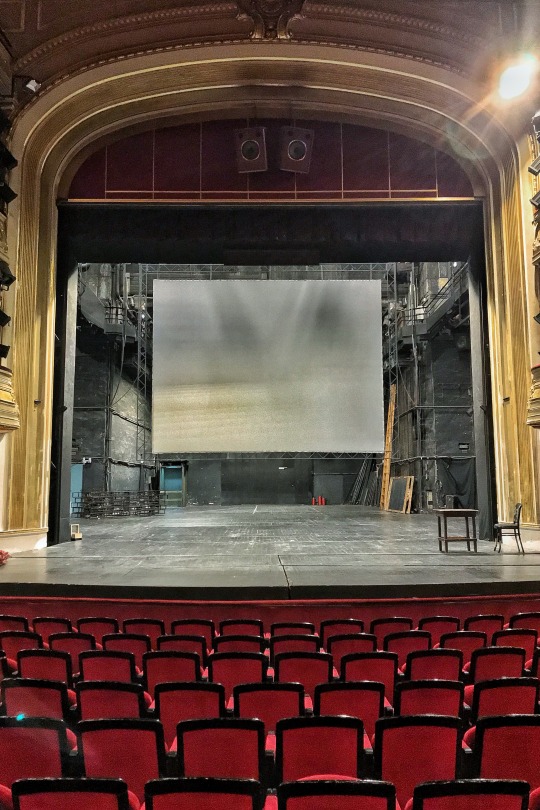
Belgrade National Theatre Main Stage with its 700 seats.

We were able to see the depth of the stage back, where sets could be
In the 1860s, the culture and the spirituality of Belgrade and its citizens were dangling between the European and Ottoman realm, gradually picking up speed in adapting the western taste and trends in culture, art and lifestyle, and urgent demand of educational and cultural institutes was rising amidst the national awakening of the country.
Under the patronage of Prince Mihailo, several amateur productions proceeded the construction of the theatre building, after which under the request of the Prince, the ensemble from the Serbian National theatre, which had been established in 1861, joined the project.
Tragically, Prince Mihailo did not live to see the start of construction of the theatre, having been assassinated on June 3rd 1868.
Today his statue stands at the heart of Republic Square, as if to oversee its history since.
Today, the theatre holds three ensemble, each of opera, ballet and theatre. Along with the Belgrade National Museum, the National Theatre is the artistic and cultural symbol of Belgrade.
0 notes
Text
Bovary - Bastille Theatre
by Tiago Rordigues
Text&Direction Tiago Rodriguez/ Based on the novel Madame Bovary by Gustave Flaubert and on the Flaubert trial/ French translation by Thomas Resendes/ Lightings Nuno Meira /Scenography and costumes Ângela Rocha/ Decorum construction Marion Abeille
1-28th March, Théâtre de la Bastille (Paris)

Simple, powerful, and enchanting!! Having had high expectation from the beginning because of good stories about it from multiple sources, I managed to score a last minute ticket on my second try, a competition rarely experienced in Paris.
I was not dissapointed by Tiago Rodegueris’s delightfully subtle layering of dual reality on stage. Metatheatrical techniques are no where near new on modern stage, but the style with which he employs it!! The admirable control over multiple dimensions, each of a letter by the author reflecting on a trial concerning Madame Bovary, the content of this novel, and of the trial itself reconstituted according to the actual stenography, resulted in an effect of utter inclusion.
REALLY, better said than done.
#gustave flaubert#bovary#madame bovary#tiago rodriguez#theatre de la bastille#bastille theatre#theatre
1 note
·
View note
Text
Le Domino Noir - Opéra Comique (Paris)
MeS: Valérie Lesort &Christian Hecq.

Unexpectedly delicious mes w/stunning scenary, a.i. large window/clock resembling that of the Orsay dividing stage front/back, also a clever device to allow the abstractly jubilant dance hall from acting space, all the while reflecting the baroque sense of time in livret.
It was also significant that performative effort was directed to every small scenes and their details, throughout the opera, from the lovable quaintness of the ball scene choreography to the vivacious swaying and turning of the tables in the second act.
Personally, I would love for as many of our little fellow audiences to witness this piece, rather than many of the spectacles specifically oriented for children !
All in all, a delightful experience.
0 notes
Text
The Prisoner - Bouffes du Nord Theatre (Paris)
directed by Peter Brook
Text and direction by Peter Brook and Marie-Hélène Estienne/ Lighting Philippe Vialatte/ Scenic elements David Violi/ Costume Assistant Alice François
Performed by Hiran Abeysekera, Ery Nzaramba, Omar Silva, Kalieaswari Srinivasan and Donald Sumpter
ピーターブルック新作The Prisoner『囚人』
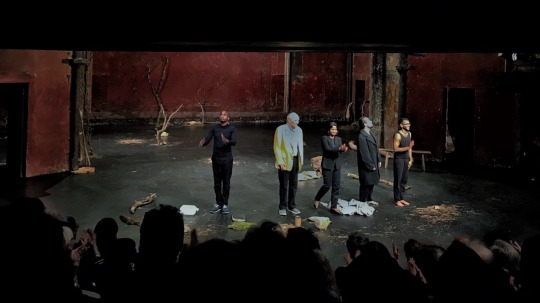
前作バトルフ���ールドはKAATで観たが、やはりホームの力はすごい。でも場の力だけではなく、本作の主題である正義、捕囚、償いといったテーマやその扱いが、個人的には強い現在性をもって感じられた。
Pondering back on my memory of #ThePrisoner. Problematic of the play called out stronger to me than his last work #TheBattlefield which I saw in Tokyo. Intimacy of the @BouffesDuNord allowed for us to integrate the problem of justice, imprisonment, and compensation as our own.
Hoping to follow up later about this work.
追記予定。
0 notes
Text
Note : « Le Songe d’une nuit d’été » by William Shakespeare, Music by Felix Mendelssohn and Choreographed by George Balanchine (L’Opéra national de Paris - Opéra Bastille March 9 - 19, 2017)
『真夏の夜の夢』W.シェイクスピア作, フェリックス・メンデルスゾーン作曲, ジョージ・バランシン振付 (パリオペラ座 - オペラ・バスティーユ 2017年3月9日-19日)

Photo by Agathe Poupeney
0 notes
Text
Note : « Ashiatohime - Footprint Princess » Written and directed by Hideki NODA (Tokyo Metropolitan Theatre Playhouse January 18, 2017 - March 12, 2017)
『足跡姫』作・演出野田秀樹 (東京芸術劇場プレイハウス 2017年1月18日-2017年3月12日)
Feeling at loss in the end. The discomfort that I felt upon seeing this hommage by the author to his best friend, or better his “kindred spirit”, the late Kanzaburô Nakamura XVIII, may have been caused by the fact that this was, despite the professional and polished execution, an extremely personal piece, which in the end rejected not only the participation, but even the witnessing of us the spectator, and even the fictional plot itself and its characters.
« Life leaves Izumo Okuni III,IV.
SARUWAKA : Okuni... curtain! Draw the curtain! If only the curtain is drawn, this would turn out a play. Big sis would wake up behind the curtain, as if nothing had happened, just as long as the curtain is drawn. The death will become “fake”. And then tomorrow, Okuni would get on the stage again... Sis, we must stay on stage. Again and again, we must die our fake “death”... And yet your body keeps disappearing, slowly, slowly, right beneath my eyes. »
『 三、四代目出雲阿国、こと切れる。
サルワカ 姉さん……幕だ! 幕を引いてくれ!ここで幕が引かれさえすれば、芝居になる。幕の後ろで、姉さんはケロッと起き上がる。ニセモノの「死」になる。そしてまた明日も、姉さんは舞台に上がる。……姉ちゃん、僕たちは舞台の上にいなくてはいけない。何度も何度も、ニセモノの「死」を死に続けなくてはいけない……だのに姉さんの肉体が、ゆっくり、ゆっくりと目の前で消えていく。』
0 notes
Text
Note : « La Flute enchantée » music by A.W. Mozart + libretto by Emanuel Schikaneder, directed by Robert Carsen (L’Opéra national de Paris - Opéra Bastille January 23 - February 23, 2017)
r『魔笛』A.W.モーツァルト+エマヌエル・シカネーダー作, ロバート・カーセン演出 (国立パリオペラ座 - オペラ・バスティーユ 2017年1月23日-2月23日)
Throughout the first act the only decorum is the projection of a forest as the backdrop, with only change of weather and the occasional flutters and bustles of the forest critters to add to it. The projection was beautifully appeasing, but also somewhat dull by the end of the act. Act two saw a little more movement, with catching visual imageries such as the ladders and the descent into the grave. The singers were all dressed in modern costumes, with Tamino and Pamina in white and both The Queen of the Nights and her three ladies, Zarastro and his people in black with mourning veils.
Carsen’s interpretation of the libretto is that the series of trials for Tamino and Pamina has been provided by the grown-ups, Zarastro and the Queen of the Night, as initiation into adulthood, or “human”hood ( or maybe into citizen hood , of being a member of their community). This rendering seems to have ripped from me so many emotions that this opéra comique brings to me, as the ambiguity and irrationality of the plot are diminished into a coldly legitimate “human resource development program”.
There were interesting aspects such as the portrayal of the three children(who appeared on stage playing soccer! and changed their costumes accordingly in sympathetic gesture to Pamina and Papageno/Papagena couple), the image of grave and death, and the subtle beauty of the forest projection, but overall I was sorry to find that the direction seemed to intentionally omit certain comical, or fun aspects clearly written into Schikaneder’s libretto.

Carsen focused on death, which is all too good for him, but I would have loved to see a little more life from the inanimate characters, which may have stoppe the little boy and his parents who sat in front of me to return for the Act two...
0 notes
Text
« Vu du pont (A View from the Bridge) » by Arthur Miller, directed by Ivo van Hove (ODEON, Théâtre de l'Europe - Ateliers Berthier January 4-February 4, 2017)

Photo by myself
It was my first time visiting the Ateliers Berthiers of Théâtre Odéon, which situates at the North-west edge of Paris at Porte de Clichy, a site currently surrounded by autoroutes under construction, seeming to seclude the entire theatre from the liveliness of central Paris.
Ivo van Hove first created his version of A View from the Bridge by Artur Miller in April 2014 at the Young Vic in London. According to Van Hove, his initial inspiration on directing this play occurred while he was researching for the creation of Rocco et ses frères(Rocco and His Brothers, 1960), which took its plot from the film by Luchino Visconti of the same title, which treated the immigration from south to north Italy. A View from the Bridge in turn tells the tale of the Italoamerican immigration, and the direction of the Italian version of the play in 1958 by Visconti is thought to have inspired him in certain ways in the creation of his aforementioned film. Now, the theme of immigration and its conflicts are extremely actual themes for the world today, and in this sense the direction of the play by Van Hove, or might I say his re-creation, was certainly a meaningful act.
Hear more from the director here:
youtube
The play was written upon the request of Miller’s friend, a lawyer, who shared with him a true story concerning the scandalous events which occurred to one of his clients, a longshoreman. The piece was originally conceived as an one act verse drama in 1955 and staged in Broadway, but the initial production being unsuccessful, the playwright revised the work into a two-act prose drama, premiered in October 11, 1956 at New Watergate theatre club in London under the direction of Peter Brook.
The piece features the area surrounding Brooklyn Bridge in the 1950s, an Italoamerican neighbourhood in which the narrator, Lawyer Alfieri runs his business. The narrator first recounts how the majority of the inhabitants are now second-generation Sicilians, who have more or less assimilated into the American culture and society, and have learnt to « settle for half-measure », or « faire des compromis » according to the translation by Daniel Loayza. Yet Eddie, the protagonist of the play, is the few who could not learn to « settle for half ».

Photo by Thierry Depagne
He is a proud docker, living with his wife, Beatrice and her niece, Catherine, whom Eddie had sworn to raise and provide for when she was orphaned as a little girl. As the play opens, Kathie proposes to Eddie her plan to start working, which Eddie initially disapproves but later agrees to. It is on the same night that they welcome two newcomers, Marco, Beatrice’s cousin and his brother Adolpho, into their apartment. The strong bond that Eddie, Beatrice and Cathy shared is put to test when they welcome the two new members into their home, their little doll’s house, where time has stopped and all remained the same for years, where Cathy always stayed a little girl.
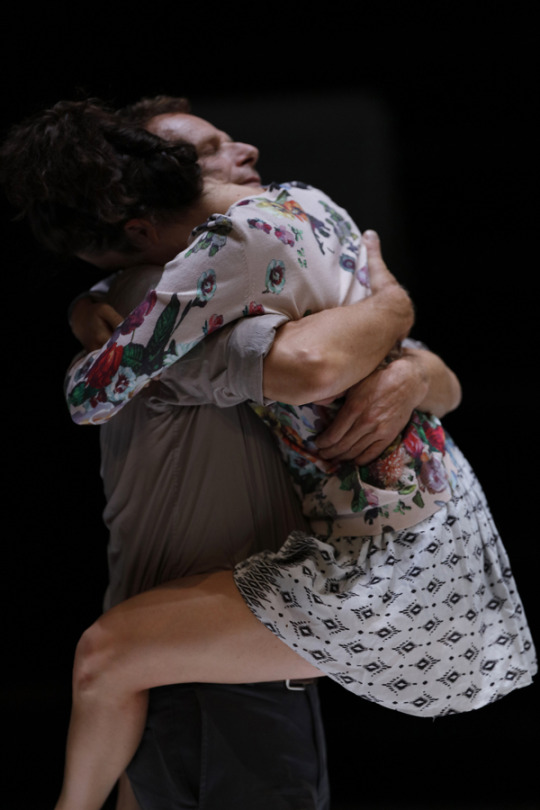
Photos by Thierry Depagne
But when the clock starts ticking once again, they are all faced with the fact that she has indeed grown, that she can not jump into Eddie’s arms the way she used to. While Eddie refuses this change, Beatrice accuses his obsession with Cathy, and Cathy in turn rapidly ventures out to explore the new concept of independence, to work and to love. Eddie’s frustration is not understood by anyone, not even the lawyer Alfiéri, and the unstoppable descent towards the tragedy begins when he tries to take the matter into his own hand...
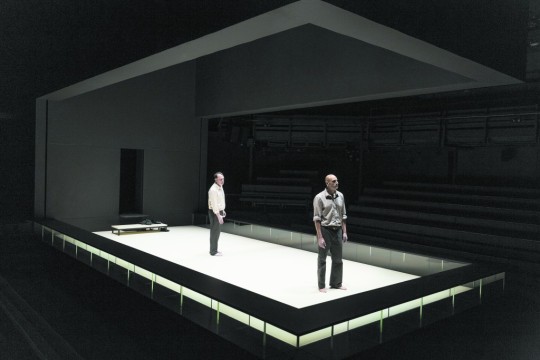
Photo by Jan Versweyveld (London Production, 2014)
For his creation, Ivo Van Hove and Jan Versweyveld created a simple yet efficient acting space as shown above, with one doorway and a white rectangular stage with black boards secured horizontally with acrylic boards at about 30cm from stage surface, having multiple functions on this decor-less stage. The thick black wall seen overhead was what actually functioned as the curtain, which was lowered to meet the black boards below to create a huge blackbox, closed before the opening of the act and concealing the entire stage from the view of the spectators, as shown below.

Photo by myself
A certain use of water was also extremely important in this direction, which I will refrain from going into details but merely mention that it was to signify the shedding of blood at the climax of the play. The representation of blood is what amazes me and disgusts me at the same time in Van Hove’s direction, sentiments which strongly resembles that evoked by his direction of Les Damnés, of which I just saw the reprise at the Comédie-Française.
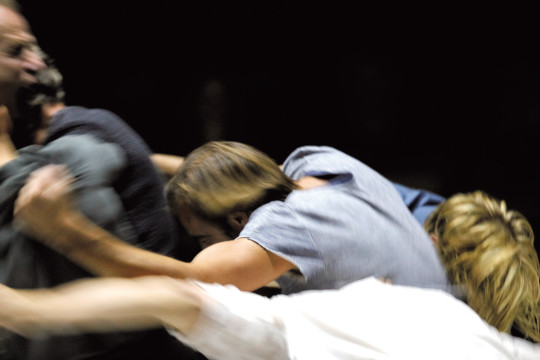
Photo by Thierry Depagne
The actors’ performance, led foremost by Charles Berling who played Eddie, was formidable, oscillating between introspective reflection and sudden bursts of anger and ferocity. Alain Fromager, incarnating Alfieri, remarkably portrayed how the lawyer, born in Italy and raised in America, synchronised with Eddie, and by enacting how he himself was cornered as the tragedy proceeded. Caroline Proust too was the driving force of the entire play in discreet manner, with her nervous glances driving the plot into the inescapable crash. Nicholas Avinée and Pauline Cheviller, the lovers, were not only fresh but showed the depth that young reflections could reach in a very short period of time. Laurent Papot who played Marco was the opposing pillar to Eddie and Alfiéri, with his own anger and vengefulness, aroused especially because of the deep affection for his family. The physical ability of the entire cast was admirable, as their bodies represented any change in scenery or the passing of time.
The use of drums expressing the taught atmosphere were effective, especially during the conversation in the second half of Act 1, accompanying the technique Van Hove employed of the spacing between the lines, to signify the prolonging of time experienced by the uneasy characters. The drums also reminded me of Noh theatre, along with the use of chorus at the beginning of Act 1 and in Act 2 during the intense conversation between Rodolpho and Catherine, where the latter definitively obtains initiative over her own sexuality. Ivo van hove has likened Miller's drama to Greek tragedies in the interview linked earlier:
« I consider Arthur Miller as one of the most important playwrights of our time. He is capable of bringing to the stage real social, political, and moral issues, in the way that Greek tragedy is capable of doing. So I consider him on that height. » I have not seen reference however to Noh, so the association is for the moment purely mine.
The current presentation at the Ateliers Berthiers is the reprise of the French version created last year at the same theatre, and is being played by the same cast members as its creation.
GÉNÉRIQUE :
traduction française Daniel Loayza
dramaturgie Bart van den Eynde
décor, lumière Jan Versweyveld
costumes An D’Huys
son Tom Gibbons
collaborateurs artistiques à la mise en scène Jeff James, Vincent Huguet
avec
Nicolas Avinée Rodolpho
Charles Berling Eddie
Pierre Berriau Louis
Frédéric Borie Le policier
Pauline Cheviller Catherine
Alain Fromager L’avocat Alfieri
Laurent Papot Marco
Caroline Proust Béatrice
5 notes
·
View notes
Text
『橋からの眺め』アーサー・ミラー作:イヴォ・ヴァン・ホーヴェ演出 (ヨーロッパ劇場オデオン座 - アトリエ・ベルティエ 2017年1月4日 - 2月4日)
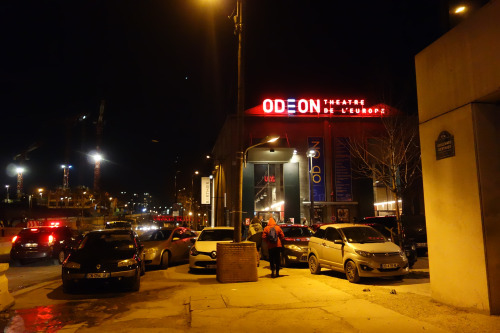
Photo by myself
オデオン座の別館であるアトリエ・ベルティエは、パリの北西ポルト・ド・クリシーに位置する。現在その周辺には至る所に道路工事のフェンスが立てられ、劇場全体がパリ中心部の賑やかさから隔てられてような感じを与える。
イヴォ・ヴァン・ホーヴェが最初にアーサー・ミラーの『橋からの眺め』を手掛けたのは2014年4月、ロンドンはヤング・ヴィクでのことだった。演出家によれば、この作品の上演を意識したのは『ロッコとその兄弟』の演出のために資料調査をする上でのことだったという。ヴィスコンティの同名映画(邦題『若者のすべて』, 1960)に題材をとる本作は、あるイタリア人兄弟の南から北への「上京」、あるいは「移民」を描いている。一方の『橋からの眺め』はイタリアからアメリカ合衆国への移民を描いており��さらに1958年にヴィスコンティにとってこの戯曲のイタリア上演の演出を1958年に手がけたことが、上述の映画の制作に影響を及ぼしたと考えられている。移民・移住とそれに伴う諸問題という極めて今日的なテーマに取り組んでいるという点で、ヴァン・ホーヴェによる今作の上演、あるいは再演には意義がある。
演出家自身のインタビューはこちら:
youtube
『橋からの眺め』はミラーの友人であったとある弁護士が、顧客であった港湾労働者に起きた出来事をもとに執筆されたとされる。当初は1幕韻文劇の形式だったが、ブロードウェイのコロネット・シアターでの1955年の初演が不評だったために、ミラーは戯曲を2幕散文劇へと書き換えた。これが1956年10月11日にロンドンはニュー・ウォーター・ゲート・シアター・クラブで、ピーター・ブルックの演出によって改めて初演された。
本作の舞台は1950年代ニューヨーク、ブルックリン橋周辺のイタリア系移民居住区であり、ナレーターとなる弁護士アルフィエリは地区内に事務所を構えている。アルフィエリによって居住者の大半がシシリア移民2世に当たること、そして彼らが多かれ少なかれアメリカの文化・社会に順応していることが語られる。彼らは「妥協」を覚えたのだという。しかし本作の主人公・エディーをはじめ、未だ「妥協」しない者たちもいる。

Photo by Thierry Depagne
エディーは港で働く荷揚げ人で、妻ベアトリスとその姪キャサリンと3人で暮らしている。エディーは幼くして両親を亡くしたキャサリンを引き取り、不自由なく育てることに心血を注いできた。幕開きとともに、キャシーはエディーに就職の話があることを打ち明け、エディーは反対の末にしぶしぶ同意する。その夜、ベアトリスの従兄弟マルコとその弟アドルフォがイタリアから密航者として到着し、エディーは彼らを招き入れる。新たに2人をその家庭に、時が止まり、キャシーがいつまでも小さな女の子でいられた彼らの「人形の家」に招き入れたことで、エディー、ベアトリス、キャサリンの絆、彼ら「家族」の有り方に疑問が呈される。

Photos by Thierry Depagne
けれど時計の針は再び動きはじめ、少女が今や大人の女性になっていたことに、これまでのように無邪気にエディーの腕に飛び込むことが、もはや許されないのだというその事実に、それぞれが向き合うことを迫られる。エディーが変化を拒否する一方で、ベアトリスは彼のキャサリンへの執着を非難する。キャサリンは新たな自由を得て、仕事に恋にと外の世界へ飛び立っていく。エディの苛立ちは誰にも理解されず、弁護士アルフィエリにもその正当性を否定される。遂に自ら解決しようと彼が決意したとき、物語は避けようのない悲劇への下降が始まる……。

Photo by Jan Versweyveld (London production)
本演出に際して、イヴォ・ヴァン・ホーヴェとヤン・ヴェルウェヴェルドは上の画像にみられるように、シンプルながらも効果的な演技スペースを作り上げた。短辺に出入り口が一つある長方形の白い舞台は、アクリルボードに支えられて舞台表面からおよそ30cmほどの高さに水平に舞台をぐるりと黒い板に囲まれている。道具類の少ない本演出において、この板が椅子や寝台といった様々な役割を兼ねることとなる。俳優の頭上に見える黒い分厚い壁は、緞帳の役を果たし、下ろされると前述の黒い板の部分に設置して大きなブラックボックスを成す。これは開演前には下ろされており、下の写真のように舞台全体を観客席から覆い隠していた。

Photo by myself
また、その詳細を述べることは控えるが本演出では水の使用が鍵となっており、クライマックスで流れる血を表すのに用いられることとなる。ヴァン・ホーヴェの演出における血の表現には、驚きと嫌悪を同時に呼び起こされ、それは先日コメディ・フランセーズにて再演を鑑賞した『レ・ダネ』にも共通する所感であった。

Photo by Thierry Depagne
エディを演じたシャルル・ベルランを筆頭に、自閉的な内省と爆発的な怒りの間を揺れ動く俳優陣のパフォーマンスはいずれも目を見張るものであった。アラン・フロマジェは、イタリア生まれアメリカ育ちの弁護士アルフィエリが悲劇の進行とともに追い詰められる様子を見事に演じることで、アルフィエリとエディとの共鳴を示す。キャロリーヌ・プルーストもまた、神経質な眼差しによって物語を破滅へと追い立てる作品全体の影の推進力となっている。ニコラ・アヴィネとポーリーヌ・シュヴィエの恋人同士は、ただ若々しいだけではなく、幼き省察が時に驚くべき速さで深みを増す、その過程を演じてみせた。アランを演じたローラン・パポはエディとアルフィエリと対置された柱であり、彼の怒りと復讐心は、家族への限りない愛情がゆえに一層激しく掻き立てられる。場面転換や時間の経過を示す俳優陣の身体の制御もまた見事なものだった。
緊迫した空気は規則的な太鼓のような音で高められていたが、これは特に第1幕後半の一同の会話のシーンで効果的に用いられていた。この場面でイヴォ・ヴァン・ホーヴェは、セリフの間に独特の「間」を設けることで登場人物たちの過ごす気まずさと、それによる時間の感覚の変化を表現している。また太鼓の使用は能舞台を思い起こさせる。1幕冒頭や、2幕のロドルフォとキャサリンの緊迫した対話の果てに、キャサリンが遂に自らのセクシュアリティの手綱を握る場面で用いられた合唱の使用によっても、能やギリシャ劇の構造が想起される。イヴォ・ヴァン・ホーヴェは上にリンクしたインタビューの中でミラーの戯曲とギリシャ悲劇を次のように語っている:「アーサー・ミラーは現代の最も重要な劇作家の一人だと思っています。彼は現実の社会的、政治的、そして倫理的な問題を、ギリシャ悲劇がそうすることが出来たように、舞台に上げることが出来るのです。彼はその高みにあるのだと、私は考えています。」今のところ演出家自身による能楽への言及は目にしていないので、その所感はあくまで私自身のものであると断っておく。
現在アトリエ・ベルティエで上演されている演出は、ロンドンでの制作を基に昨年同劇場で制作されたフランス版演出の同一キャストによる再演である。
GÉNÉRIQUE :
traduction française Daniel Loayza
dramaturgie Bart van den Eynde
décor, lumière Jan Versweyveld
costumes An D’Huys
son Tom Gibbons
collaborateurs artistiques à la mise en scène Jeff James, Vincent Huguet
avec
Nicolas Avinée Rodolpho
Charles Berling Eddie
Pierre Berriau Louis
Frédéric Borie Le policier
Pauline Cheviller Catherine
Alain Fromager L’avocat Alfieri
Laurent Papot Marco
Caroline Proust Béatrice
0 notes
Text
« Les Damnés » by Luchino Visconti, Nicola Badalucco and Enrico Medioli : Directed by Ivo van Hove (Comédie-Française Salle Richelieu, September 24 2016 to January 13 2017)
The play of the night was first created for the Cours d’Honneur at the Festival d’Avignon last July, marking the return of the Comédie-Française to the notorious festival after 23 years of absence. For the occasion, Éric Ruf, the current general administrator of the company invited Belgian theatre director Ivo van Hove, known for his direction of Toneelgroep Amsterdam in Netherland. The play is a variation of Luchino Visconti’s film The Damned(1969), but the creators repeatedly reminds us that it is not an adaptation of the film itself, but a work which shares its scenario, authored by Visconti himself, Enrico Medioli and Nicola Badalucco.
The scenario portrays the damnation of the von Essenbeck family, a German bourgeois running a large steel company, under the pressure of the rising Nazi reign and by the collision of the darkest desires and secrets within the family, of greed, of lust, and of hatred.
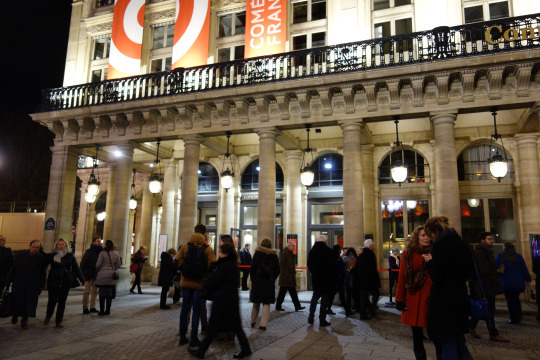
Having received great attention and later acclamation, the biggest focus for its reprise in Paris was how the play, originally created for an open-air stage at Palais de Pope translated itself for the classical proscenium arch stage of Salle Richelieu.

Photo by Christophe Raynaud de Lage(at Festival d’Avignon, Cour d’honneur of Palais de Pope)
As seen above, the original stage consisted of an orange acting space at stage centre, with 6 coffins lined to stage left, and a dressing and makeup space to the stage right. This basic arrangement was not altered, but at Salle Richelieu, the acting taking place off of the orange acting space was, although greatly depending on seat positions, visually compromised. Below is an example of the limited view from an attic seat.
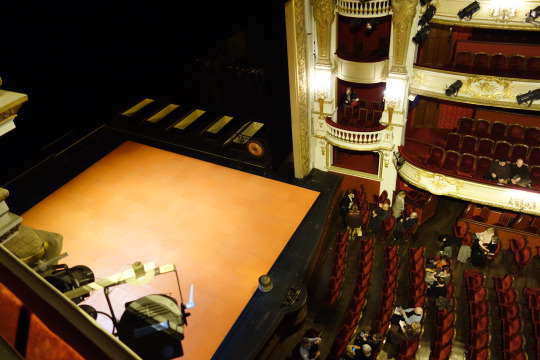
You will also be able to get an image of the view from the ground seats from this video by Entrée libre:
youtube
Not having seen the original production at Avignon, I found the version Richelieu to be deeply satisfactory. True, the architecture of the theatre resulted in optical limitations in numerous scenes, and different ambiances were born for these tableaus. Still, the employment of live video-recording and projection on scene has for this play worked to tolerate such defaults, if not allowing the audience to share the feeling of suffocation looming over the Essenbeck mansion and its many closed doors.

Photo by Christophe Raynaud de Lage (Festival d’Avignon)
And vice versa, because of this element of secrecy and enigma that was to be revealed through the lenses and magnified by the projection on screen, the introduction of live-recording on stage seemed justly incorporated into the mise en scène. The camera and projection allowed a new dimension to the dramatic techniques, by showing historical references and captions, providing close-ups of the actors’ facial and physical expressions, translating the footage to monochrome, capturing and showing symbolic scenes and objects as scenery, and even providing simultaneous composite images which in turn contrast to the actual performance on stage.
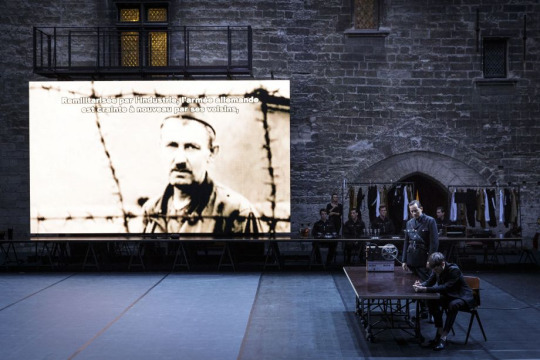
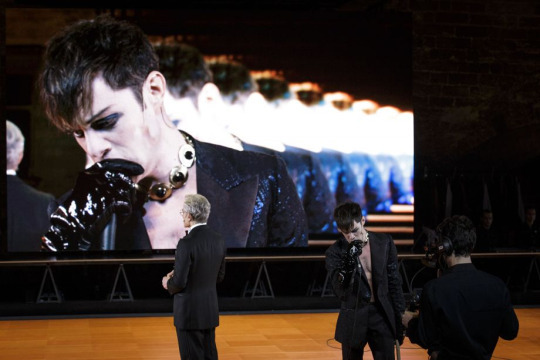
Photos by Christophe Raynaud de Lage (Festival d’Avignon)
What surprises me about Ivo van Hove’s direction was the utter delicateness with which he unites the extremely harsh and violent elements of this mise en scène. There was rawness to the textures he chose to highlight: silver, ashes, blood, tar, and feather. Nudity, violence, incest, pedophile and repeated imagery of death was put on stage. The sound effects too were given raw edges by the employment of Chinese gongs and the high-pitched whistling sounds, the former announcing another death and the latter symbolising the family’s shared asset/curse, the steel plant. Yet the Belgian director managed to orchestrate these into a wondrously sophisticated masquerade of human desires and their failures, so much so that the spectators wince at the sight of blood splashed on stage in the admirable scene in the later half of the performance portraying the « Night of the long knives », with composite image of pre-recorded and live-recorded videos.

Photo by Christophe Raynaud de Lage
GÉNÉRIQUE :
Les Damnés d’après le scénario de
Luchino Visconti, Nicola Badalucco et Enrico Medioli
Mise en scène Ivo van Hove
Scénographie et lumières Jan Versweyveld
Costumes An D’Huys
Vidéo Tal Yarden
Musique originale et concept sonore Eric Sleichim
Dramaturgie Bart Van den Eynde
Assistanat à la mise en scène Laurent Delvert
Assistanat à la scénographie Roel Van Berckelaer
Assistanat aux lumières François Thouret
Assistanat au son Lucas Lelièvre
avec
Sylvia Bergé la Gouvernante et la mère de Lisa (jusqu'au 7 novembre)
Éric Génovèse Wolf von Aschenbach
Denis Podalydès Baron Konstantin von Essenbeck
Alexandre Pavloff le Commissaire et le Recteur
Guillaume Gallienne Friedrich Bruckmann
Elsa Lepoivre Baronne Sophie von Essenbeck
Loïc Corbery Herbert Thallman
Adeline d’Hermy Elisabeth Thallman
Clément Hervieu-Léger Günther von Essenbeck
Jennifer Decker Olga
Didier Sandre Baron Joachim von Essenbeck
Christophe Montenez Martin von Essenbeck
et
Sébastien Baulain Janeck
1 note
·
View note
Text
『レ・ダネ』ルキノ・ヴィスコンティ, ニコラ・バダルッコ, エンリコ・メディオリ作:イヴォ・ヴァン・ホーヴェ演出(コメディ・フランセーズ リシュリュー劇場, 2016年9月24日より2017年1月13日)
今宵の演目は、昨年7月のアヴィニョン演劇祭クールドヌールにて、実に23年ぶりとなるコメディ・フランセーズの参加を飾った作品である。総支配人のエリック・リュフは、トネルフループ・アムステルダム芸術監督をつとめるベルギー出身の演出家イヴォ・ヴァン・ホーヴェに制作を委ねた。
本作はルキノ・ヴィスコンティの映画『地獄に堕ちた勇者ども』(1969)のヴァリエーションだが、製作者達が繰り返し強調するように、映画そのものの翻案劇ではなく、同じヴィスコンティとエンリコ・メディオリ、ニコラ・バダルッコが共作で手がけた映画のシナリオに基づいた演劇化作品である。
物語はナチスの勃興を背景に製鉄業を営むフォン・エッセンベック家を舞台として、一族に渦巻く野心、肉欲、そして愛憎といった黒い欲望と秘密と、それによる一家の破滅を描く。

Photo by myself
アヴィニョンで大いに話題と評価を得た本作のパリでの再演にあたって大きな焦点となったのは、教皇庁の野外ステージのために制作された本演出が、どのように古典的なプロセニアムアーチにふちどられたリシュリュー劇場の舞台にハマるかという点であった。

Photo by Christophe Raynaud de Lage(at Festival d’Avignon, Cour d’honneur of Palais de Pope)
上に見られるように、初演時の舞台は中央のオレンジ色の演技スペースに、黒で統一された上手の6つの棺、そして下手の衣裳・メイクスペースで成り立っている。この基本的な構成に変化はなかったものの、パリでの再演では、オレンジの演技スペース以外の舞台上で演じられる場面は、席によれど多くの観客にとって、目視しがたいものとなる。以下の写真は、いわゆる桟敷席にあたる4階席下手側からの視界の一例だ。

一階席正面からの視界については、下のビデオから確認することが出来る。
youtube
アヴイニョンでの初演を観劇していない立場からではあるが、今回の再演は素晴らしい出来であった。事実、劇場の構造上、多くの場面において観客の視野には制限が加えられたために、各景のニュアンスは異なるものとなっただろう。しかし、舞台上でのライブ・レコーディングとプロジェクションはこうした欠点が補われただけでなく、エッセンベック邸と邸内の閉じられた扉の数々にまとわりつくように垂れ込める閉塞感を観客に伝えるために働いていた。

Photo by Christophe Raynaud de Lage (Festival d’Avignon)
また同時に、こうした秘密や謎といった要素が、レンズを通して暴かれ、拡大されスクリーンに投影されるという手法は、舞台上にカメラを上げて撮影を行うという今回の映像手法を自然な形で演出に組み込む結果となっている。
カメラとスクリーンは、歴史的な資料映像や字幕によるキャプション、俳優の表情や身体のクロースアップ、映像の白黒化やネガ化、象徴的な場面や物品の静止画、あるいは録画された映像を舞台上の演技と組み合わせることによって、舞台上の実際の風景と対比させるといった様々な手法によって、劇技法に新たな次元をもたらしている。


Photos by Christophe Raynaud de Lage (Festival d’Avignon)
ヴァン・ホーヴェの演出は恐ろしく刺々しく、暴力的な要素を組み合わせながらも、それらを驚くべき繊細さで積み上げる。彼が用いた素材にはある種の生々しさ、辛辣さがあった:銀、灰、血、タール、そして羽。裸体、暴力、近親相姦、小児性愛に加え、死のイメージまでも、衒いなく描かれてゆく。音響面でも、銅鑼や甲高い汽笛の音といった原始的な音を用いることで、それぞれ反復される死、一族の共有資産である製鉄所を想起させる。それでいて、ヴァン・ホーヴェはこれらを束ねて、洗練された人間の欲望と挫折の仮面舞踏会に仕立て上げている。だからこそ観客は劇後半の「長いナイフの夜」の虐殺を描いたシーンで、舞台にぶちまけられる血の赤さに揃ってうめき声を漏らすのだろう。

Photo by Christophe Raynaud de Lage
GÉNÉRIQUE :
Les Damnés d’après le scénario de
Luchino Visconti, Nicola Badalucco et Enrico Medioli
Mise en scène Ivo van Hove
Scénographie et lumières Jan Versweyveld
Costumes An D’Huys
Vidéo Tal Yarden
Musique originale et concept sonore Eric Sleichim
Dramaturgie Bart Van den Eynde
Assistanat à la mise en scène Laurent Delvert
Assistanat à la scénographie Roel Van Berckelaer
Assistanat aux lumières François Thouret
Assistanat au son Lucas Lelièvreavec
Sylvia Bergé la Gouvernante et la mère de Lisa (jusqu'au 7 novembre)
Éric Génovèse Wolf von Aschenbach
Denis Podalydès Baron Konstantin von Essenbeck
Alexandre Pavloff le Commissaire et le Recteur
Guillaume Gallienne Friedrich Bruckmann
Elsa Lepoivre Baronne Sophie von Essenbeck
Loïc Corbery Herbert Thallman
Adeline d’Hermy Elisabeth Thallman
Clément Hervieu-Léger Günther von Essenbeck
Jennifer Decker Olga
Didier Sandre Baron Joachim von Essenbeck
Christophe Montenez Martin von Essenbecket
Sébastien Baulain Janeck
1 note
·
View note
Text
« Tristesses » (Anne-Cécile VANDALEM/L’Onde)
L’Onde theatre is another theatre which is located a little out of the way, about an hour’s ride out of Paris, in the city of Vélizy-Villacoublay. According to the city’s website, L’Onde is “ a place of multidisciplinary artistic creation and diffusion, mostly focusing on contemporary works, whether it be a work of theatre, of sculpture, music, dance, or of regional art”, and is more of a culture/art centre than a conventional theatre.

The play of the night was « Tristesses (Sadnesses) » written and directed by Anne-Cécile VANDALEM, a Belgian playwright/stage director/actress, and first created at the Avignon Festival this summer (2016).
The stage set almost reminds us of small figurines of houses that we would arrange into a small village. This feeling of fake-ness continues to linger in this play taking place in a fictional small island village of Danemark, not only for its decorum but also for the comportment of the characters and the procession of the plot.

Photo by : Christophe Raynaud de Lage
The village seems ever the more superficial, like a child’s play, in the sense that there are but 8 villagers remaining (consisting of: a family of father, mother, and two girls, the mother’s brother who is the village pastor, his wife, and a elderly couple), or better said 7, as the eldest member, Ida, is found hanging herself on the flag post at the beginning of the play. The near abandoned village is the result of the town’s main industry, the slaughterhouse, being shut down several years ago. The population has since then drastically decreased from 800 to 8, and now 7 by Ida’s mysterious death. Upon hearing the news of her mother’s death, Martha, incarnated by Vandalem herself, and who is a prominent female leader of the extreme right wing party of Danemark, preparing for the approaching election, returns to the island for the funeral and to transport her body to the mainland.
The spectator eventually learns how Martha’s political success has been initially boosted by her father, who was the founder of the extremist party and the former owner of the abattoir, financing the party by sacrificing his business. And her return to the island is yet again motivated by her desire, not to grieve her mother, but to gain the rights to the premise and to establish a propaganda film studio for her party. When her plot crashes with the sentiment of the residents of the island, highly condensed by years of obstruction, tragic events are inevitably triggered resulting in violence and deaths.
The performance is a melange of multiple media, of theatre, of film and of music. The two phantoms who roam silently yet freely on stage are both the musician and the cameraman, playing instruments on-stage and film recording scenes which take place within and behind the buildings, sharing the omniscient perspective to the audience.

Photo credit : Christophe Raynaud de Lage
The reference point of the play is also multi-sourced, as the eery appearance of the pale younger girl, Malene, who has lost speech from witnessing the death of the two workers, clearly draws from horror movies, while the composition of the synopsis is loosely that of pseudo-documentary, with the play closing with fictive captions acknowledging the course of the events to be non-fictional (The play was originally inspired by the actual island of Samos and how it was turned into a governmental experimentation lab).
Whenever live performance is intertwined with live or pre-recorded video footages, the question arises as to the effectivity and the necessity of mix-media. In Tristesses, the live musical performance was elegantly processed by the two phantoms, with strangely believable existence (or non-existence), later reinforced when a camera shot in one of the houses shows us a photo of one of the two phantoms, of course before their death, allowing us to understand how they too were once a member of the village.

The recording was handled in a similar manner, but presumably owing to the extremely informative nature of the medium, the unwritten rule of the methodology did not seem to me to be as coherent as it could be. What did it mean to see the scenes through these machineries, through the process of digitalisation? How did it differ to what we saw directly on stage? Was the line merely drawn at the limit of our ophthalmic abilities, to allow a peek of what was behind the walls, what we could not see with our actual eyes?

Photo credit : Christophe Raynaud de Lage
For more than half of the course of the play, the camera is hidden from the audience, up to a scene where the camera crue finally walks out of the building for the first time toward stage center carrying the camera on his shoulder. I could not however make sense of this transition, as apart from the steady rise of tension and expectation for the catastrophe, I could not see the breakpoint for this change of perspective. Symbolic shots of objects also started to be inserted near the same moment, but this also seemed to be an abundant flow of visual information at the point.
I must also mention the fact that the live-recording and editing that took place on stage did seem to limit the liberty of the performers to a certain extent, a restriction which seemed to add to the suffocating tension in some scenes whereas in others the staging seemed to be “rehearsed” in an unfortunate sense.
If I allow myself to return to the thematics, the plot was undeniably relevant to all who lives in Europe at the moment. Yet with all the freedom and power of the style of the performance, spiritual-fantasy-meets-gruesome-tragedy-based-on-real-events, in the end it seemed to do what a documentary film may have well done to us : invite us to think.
Tristesses by Anne-Cécile VANDALEM will be touring to following sites and venues : November 7-8 at the Maison de la Culture d’Amiens, November 8-9 at Volcan Scène nationale du Havre, March 15-17 2017 at the MC2; Grenoble Scène nationale, and March 21-22 at Bonnie Scnène rationale d’Annecy.
0 notes
Text
«かなしみ» (アンヌ=セシル・ヴァンダレム/ロンド・シアター)
ロンド・シアターはこれまたちょいと郊外にある劇場で、パリから電車で地時間ほどのヴェリジー・ヴィラクブレイという街にある。街の公式サイトによれば、この施設は「現��の作品を中心に、演劇、立体制作、音楽、ダンス、地域芸術とあらゆる芸術の分野横断的な創造と発信の拠点」であり、伝統的な劇場というのにとどまらない、文化・芸術センターといった趣だ。
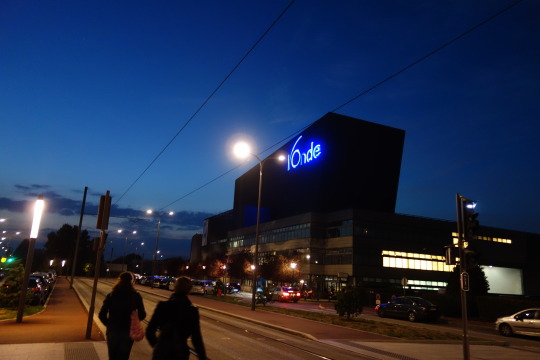
この日の演目は今夏アヴィニョン演劇祭で初演された、ベルギー出身の劇作家・演出家・女優、アンヌ=セシル・ヴァンダレム作演出出演作、『かなしみ』である。
舞台セットは、おもちゃの家を思わせるようなものである。その一種白々しいような嘘っぽさは、デンマークの架空の離島を舞台とする本作の舞台美術だけでなく、人物達の挙動や筋の進行に至るまで、通底するものに感じられた。

Photo by : Christophe Raynaud de Lage
この離島の町というのがまた実体を持たない存在であって、おままごとのようなものである。島には残る住民は8人(父母に二人の娘という一家に、その母の弟であるところの牧師とその妻、それに老夫婦)、いや劇冒頭で老夫婦のうちの妻イダが、旗竿から首を吊って亡くなっているのがみつかるのだから、7人に過ぎない。町の衰退は主産業であった屠殺場の閉鎖が原因で、以降800人あった人口がみるみるうちに8人、そしてついに7人へと縮小してしまった。ヴァンダレム演じるマルタは、島を離れて本土で極右政党の総裁となっており、母の訃報を受けて遺体を引き取るべく帰島する。
観客はやがて、マルタの政治的成功がそもそもは、島の屠殺場の経営者であった父の資金援助によるものであり、そのために島の経済と島民の生活が犠牲になったことを知る。彼女の帰郷もまた、母を悼むためというよりもむしろ、彼女の新たな政治的野心に裏打ちされたものである。屠殺場跡の土地の権利を手に入れて、党のプロパガンダ映画の撮影所の建設を目論んでいるのだ。彼女の企みが、長年の閉塞によって凝縮された島民それぞれの思いと衝突する時、悲劇的な出来事が引き起こされ、暴力と死をもたらす。
公演は演劇、映像、そして音楽といった複数のメディアを融合させたものとなっている。舞台上を自由に行き来する2人の亡霊たちは、同時に音楽家でありカメラマンを担っており、舞台上での生演奏のほか、建物内部や裏の情景をカメラで撮影してスクリーンに生中継することで、観客に全知の視点を提供する。
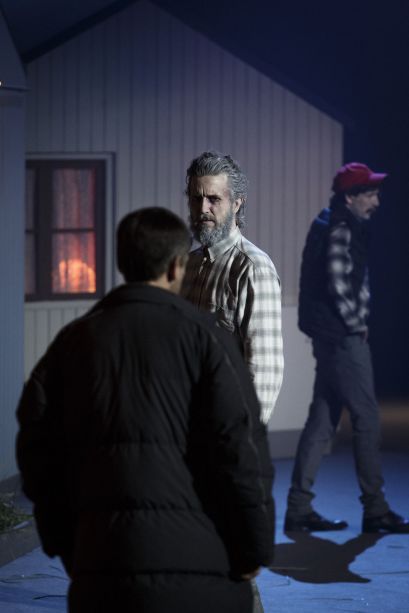
Photo credit : Christophe Raynaud de Lage
作品の参照点もまた多角的といえるだろう。姉妹の年少の娘であるマレーヌは、亡霊たちの自殺体を発見したことにより言葉を失っているのだが、彼女が音もなく人々の背後に表れては彼らを脅かすのは、ホラー映画を明確に意識しているだろうし、上演の構成自体はゆるやかな疑似ドキュメンタリー(pseudo-documentary)となっており、劇中の出来事がノン・フィクションである旨を示すフィクショナルな字幕によって舞台は幕を下ろす(本作は実際に、デンマークに実在のサモス島が政府の実験場とされたことに着想を得てはいるが、登場人物及び出来事は全てフィクションである)。
さて、ライブ・パフォーマンスが収録ないし生中継の映像と組み合わされる作��を前にして、当然浮かぶのがそのようなミックス・メディアの手法の効果と必要性ということだと思う。『かなしみ』では、2人の亡霊の存在の(あるいは非-存在の)奇妙な説得力 が、舞台上での生演奏を実に巧みに処理している。物語後半、ある食堂の壁にかけられた家族写真のなかの亡霊の(生前の)姿がスクリーンに映し出されることで、(ともすれば上演の機構と化してしまいかねない)彼らの物語世界における存在感が再度補強されているのも見事だ。
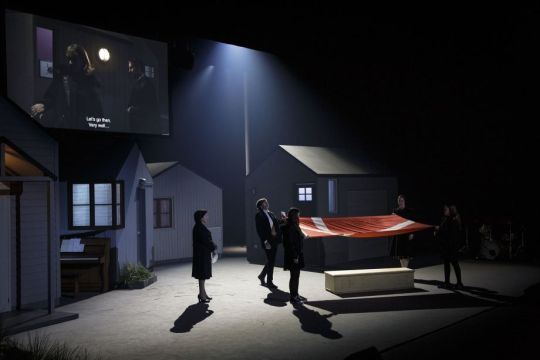
Photo credit : Christophe Raynaud de Lage
映像収録についても同様に処理されているのだが、メディア自体の性質である情報量の多さゆえもあろうが、その手法における不文律の一貫性が、ともすると不足していたように感じた。ビデオカメラという機械を通して、ある場面をデジタル化して見せることがどのような意味を持つのか。直接舞台で演じてみせることとどのように異なるのか。ただわれわれの視覚的限界で線引がなされ、すなわち直接目で見ることの出来ない壁の向こう側を見せる、ということが目的なのだろうか。
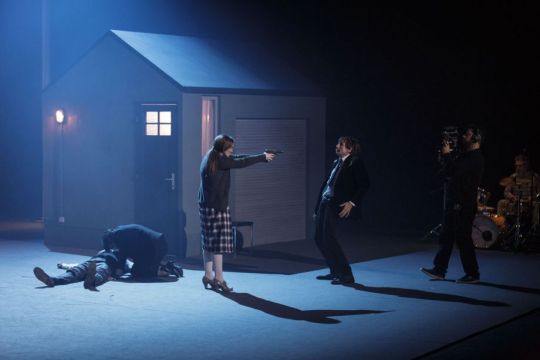
Photo credit : Christophe Raynaud de Lage
上演開始から半分以上の間、カメラは観客に直接示されないで進むが、ある時点でカメラを肩に担いだカメラマンが建物から中央の広場へと出てくる。この推移をどう捉えていいものか私にはわからなかった。というのも、惨劇の予兆と緊張感が確実に高まっていたのを除けば、この視点の遷移の分断点となるものを見いだせなかったのだ。また同時点から、象徴的であると思われる物品のショットが挿入されることがあったが、これもまた視覚的情報の氾濫に思われた。
また、舞台上での生収録及び投影が、幾分俳優たちの演技の自由を制限するかに見受けられたことにも触れざるを得ない。この抑圧は、ある場面においては息の詰まるような緊張感を高めるものと感じられたし、またある場面では残念な意味で上演の「段取り」を意識させるものであった。
作品の主題に話を戻すと、本作の筋がヨーロッパに住むすべての人にとって今日的な問題であることは間違いない。しかし、「スピリチュアル・ファンタジーかける事実に基づいて再構成した惨劇」という上演のスタイルの自由度・可能性の高さに関わらず、その作用はドキュメンタリー作品の効能と大きく変わらないように感じられてしまった。すなわち、一考を促すにとどまっているのではないか。
アンヌ=セシル・ヴァンダレム作演出『かなしみ』のツアー予定は以下の通り:
・11月7-8日 Maison de la Culture d’Amiens
・11月8-9日 Volcan Scène nationale du Havre
・2017年3月15-17日 MC2; Grenoble Scène nationale
・2017年3月21-22日 Bonnie Scnène rationale d’Annecy
0 notes